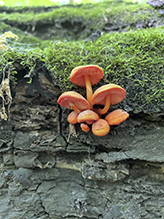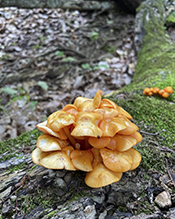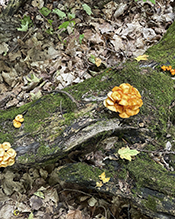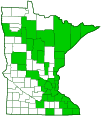Orange Mycena
(Mycena leaiana)
Conservation • Description • Habitat • Ecology • Distribution • Taxonomy
Conservation Status |
|
|||||||
| IUCN Red List | not listed |
|||||||
| NatureServe | NNR - Unranked |
|||||||
| Minnesota | not listed |
|||||||
Description |
||
Orange Mycena is a common, colorful, bonnet mushroom. It occurs in North America east of the Great plains and in the Pacific Northwest, and in Mexico and Central America. A variety of this species occurs in eastern Australia and New Zealand. It is found from June through September in woodlands, growing on the dead wood of deciduous trees. It obtains its nutrients from decaying wood (saprobic). It almost always forms tight clusters, with several stems arising from the same point. It is rarely found alone. When handled, the orange pigment will stain the skin. The cap on young specimens is oval or bell-shaped, bright reddish-orange, shiny, hairless, and sticky. The margin is curved inward. As it ages the cap flattens out, becoming broadly bell-shaped or convex to nearly flat, sometimes with a small depression in the middle. The color fades to bright orange, then paler and more yellowish. The margins sometimes become lined. The upper surface is dull and dry but becomes sticky when wet. Mature caps are ⅜″ to 1½″ (1 to 4 cm) in diameter. Older caps are sometimes almost white. The stalk is slender, 1¼″ to 2¾″ (3 to 7 cm) long, and 1⁄16″ to ⅛″ (2 to 4 mm) thick. It is often curved or wavy and is sometimes flared at the top. It is tough, cartilaginous, hollow, and sticky when wet. The color is the same as the cap, but it is often paler near the top. It is smooth except rough to the touch just near the top when young. The base is covered with long, stiff, orange hairs. When squeezed, it exudes a watery orange juice. The gills are closely spaced or crowded. They are broadly attached (adnate) or notched at the point of attachment. The surfaces are pale orange or salmon-colored, but the edges are brilliant reddish-orange. They stain orangish-yellow when bruised. The flesh is thick, yellowish-white, and watery. Edibility is unknown, but all descriptions mention that the taste is “mealy”, “not distinctive”, or “lacking”. The spore print is white. |
||
Similar Species |
||
Habitat and Hosts |
||
Woodlands Dead hardwood |
||
Ecology |
||
Season |
||
June through September |
||
Distribution |
||||
|
Sources |
|||
| 8/14/2022 | ||||
Occurrence |
||||
Common |
||||
Taxonomy |
|||
| Kingdom | Fungi (fungi) | ||
| Subkingdom | Dikarya | ||
| Phylum | Basidiomycota (club fungi) | ||
| Subphylum | Agaricomycotina (jelly fungi, yeasts, and mushrooms) | ||
| Class | Agaricomycetes (mushrooms, bracket fungi, puffballs, and allies) | ||
| Subclass | Agaricomycetidae | ||
| Order | Agaricales (common gilled mushrooms and allies) | ||
| Suborder | Marasmiineae | ||
Family |
Mycenaceae | ||
Genus |
Mycena (bonnets) | ||
Synonyms |
|||
Agaricus leaianus Collybia leaiana |
|||
Common Names |
|||
Golden Fairy Helmet Lea’s Mycena Orange Mycena |
|||
Glossary
Saprobic
A term often used for saprotrophic fungi. Referring to fungi that obtain their nutrients from decayed organic matter.
Visitor Photos |
|||||
Share your photo of this fungus. |
|||||
| This button not working for you? Simply email us at info@MinnesotaSeasons.com. Attach one or more photos and, if you like, a caption. |
|||||
Honey Fae (Farah) |
|||||
Orange Mycena clusters |
|||||
 |
 |
||||
 |
|||||
MinnesotaSeasons.com Photos |
|||||
|
|||||

Slideshows |
||

Visitor Videos |
|||
Share your video of this fungus. |
|||
| This button not working for you? Simply email us at info@MinnesotaSeasons.com. Attach a video, a YouTube link, or a cloud storage link. |
|||
Other Videos |
|||
| Beautiful Wild Fall Autumn Mushrooms Orange Mycena leaiana Walt Reven Jr |
|||
About
Oct 30, 2019 Beautiful Wild Fall Autumn Mushroom Hunting Orange Mycena leaiana. Really pretty wild mushrooms that grow in the fall/autumn months here in the ozark mountains! |
|||
| mycena leaina Doctor Mushroom - Natural Healing |
|||
About
Aug 21, 2016 Common bright orange mushroom on logs. |
|||

Created: 8/15/2022
Last Updated:


